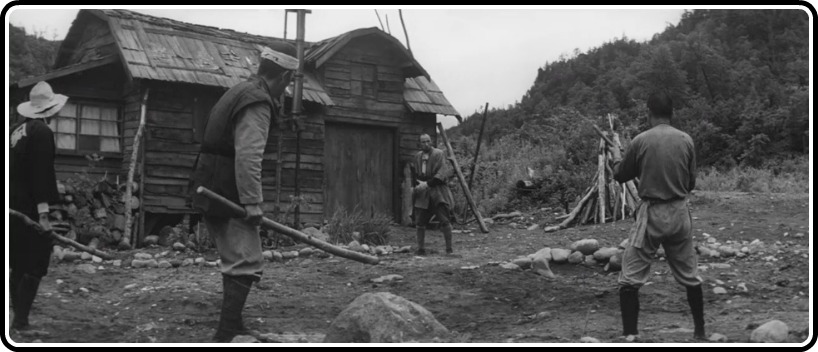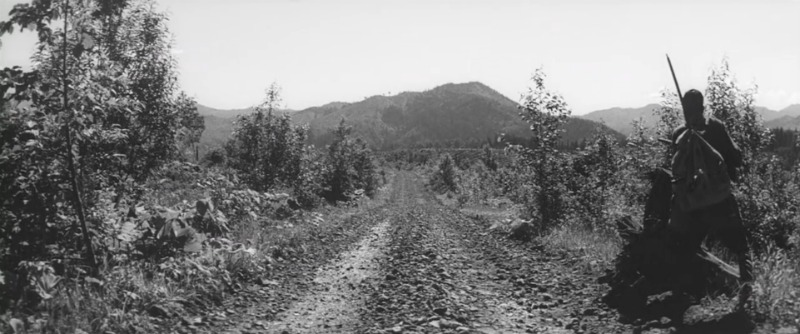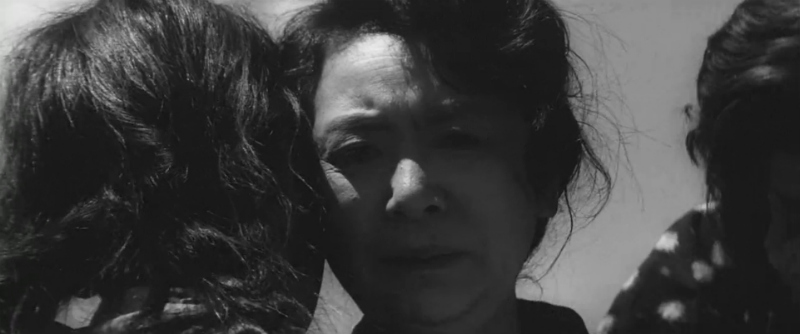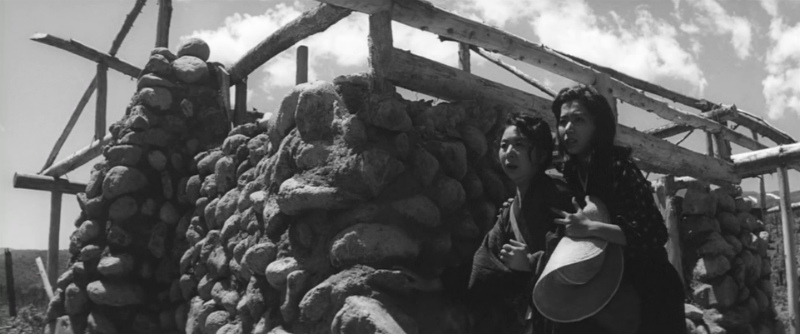
Using a sort of reverse aesthetic structure to that of Otto Preminger’s Bonjour Tristesse, prolific and wildly diverse Japanese director Keisuke Kinoshita opens his 1963 film A Legend or Was It? in the present, in spectacular color, within an almost archetypically idyll mountain village. He sets us amongst farmers who are pointedly kind, generous, and compassionate towards their neighbors. One man stops what he’s doing to mourn another’s dead horse; one man comments that the weather is too hot, to which his friend replies that they should be thankful, for they’d been fearing a cold front; two women tease each other kindly; a group helps pull a truck out of a rut. This is the absolute ideal of communal living. And then the narration informs us that things weren’t always this way, that less than twenty years ago, a “nightmare” had taken place, one that the farmers have tried desperately to put behind them.

The picture moves to harsh black-and-white. It’s near the end of World War II. The villagers know their country will soon be defeated, having heard stories from their sons who are gradually returning from the front. One such son, Goichi, son of the de facto mayor, Takamori, is to marry Kieko, the daughter of the Sonobe family, which will come to be our collective protagonist and has, in turn, wound up in the village after being evacuated from firebombed Tokyo. Her brother, Hideyuki, has also recently arrived home, and begs his family to refuse the offer of marriage, as he has witnessed Goichi commit terrible acts while at war, exploiting his sense of power by murdering innocents and raping the women of the countries they invaded. Furious at their refusal, Goichi begins targeting the family, until an act of violence compels them to strike back, and, given Goichi’s standing in the community, the Sonobe family suddenly becomes the target of the entire village, desperate for vengeance before justice even has a chance.
I tend to find these movies that “explore” mob mentality (your Ox-Bow Incident or Bad Day at Black Rock, for example) to be a little facile, and extremely easy on the viewer. They always give the mob the most grotesque characterizations possible, and make sure there’s a good, strong, reliable leading man front and center, one who’s not personally affected by the situation (lest it get too “real”), but who protests on the victim’s behalf (if we ever see the victim). He’s on hand at all times to assure you, the viewer, that you’d be just like him in such a situation.

While Kinoshita’s film is not totally bereft of such overarching concerns (though at least his drunk hicks are a lot more entertaining than those typically portrayed in American films), it does a few things differently that make all the difference. First, there is no advocate figure – a few people come in from time to time to try to stop the mob, but for the most part, the Sonobe family are their own only hope. Second, they really are responsible for the crime of which they are accused, and it is a serious one. Third, and most importantly, Kinoshita structures the second half, more or less, like an action movie, at least something more resembling a Peckinpah picture (there’s a lot in here that anticipates Straw Dogs) than a drab, contemplative affair. Because of the rush, there really is a sense that there’s no stopping this mob; it’s gone well beyond intentions into a force of nature all its own. It’s exhilarating cinema, as much for the excitement as the dread.
Nicely mirroring that is the film’s score, by Kinoshita’s brother, Chûji, who crafts two themes that often work separately, but, despite being quite different from one another (one bare and tense, the other operatic and foreboding), work quite beautifully in concert. Each, along with the other melodies throughout the soundtrack, keep the action propulsive, without turning it into entertainment, and the frequent reprisal of the themes suggests a recursive quality to the action onscreen, as though things will only continue along this track until one side is suitably dead.

A Legend or Was It? (also known in some quarters as Legend of a Duel to the Death) is a beautifully tragic picture, and is given an incredible HD presentation on Criterion’s Hulu Plus channel, with very minimal wear and tear in the source print and a very fine transfer onto video. The color section is booming, very important in conveying the serenity of this more peaceful time, and also in the visceral effect the transition to black-and-white creates. The second we’re into monochrome, it must feel like we’ve been cast down in some fashion, and while Criterion never sacrifices the beauty of the imagery, it ensures we feel as though we’re sinking in some sort of tar pit.
I’d love to see this come to Blu-ray, but between the short running time of the picture (only 83 minutes) and Kinoshita’s rather limited stature in world cinema circles, I wonder how possible that would be. I keep waiting for Criterion to do more full-fledged double-feature Blu-ray releases; given how many films they’ve offered as bonus features on single-disc releases, and to great acclaim (such as Killer’s Kiss on The Killing, The Report on Certified Copy, etc.), it would seem only natural to find a release to more directly call out this type of value. A guy like Kinoshita would be perfect for that, as many of his films are quite short, and customers more willing to take a leap of faith for such a good value. A commentary track or some sort of exploration of Japanese society on the brink of national surrender would make for great special features, along with just more information about Kinoshita.
Until such a day shall arrive, as always, this film, along with hundreds of other classics and lost treasures of world cinema are yours for the taking on Criterion’s Hulu Plus channel.
To try out Hulu Plus and get two weeks free, click here!



![Bergman Island (The Criterion Collection) [Blu-ray]](https://criterioncast.com/wp-content/uploads/2022/11/bergman-island-the-criterion-collection-blu-ray-400x496.jpg)
![This Is Not a Burial, It’s a Resurrection (The Criterion Collection) [Blu-ray]](https://criterioncast.com/wp-content/uploads/2022/11/this-is-not-a-burial-its-a-resurrection-the-criterion-collection-blu-ray-400x496.jpg)
![Lars von Trier's Europe Trilogy (The Criterion Collection) [The Element of Crime/Epidemic/Europa] [Blu-ray]](https://criterioncast.com/wp-content/uploads/2022/11/lars-von-triers-europe-trilogy-the-criterion-collection-the-element-of-400x496.jpg)
![Imitation of Life (The Criterion Collection) [Blu-ray]](https://criterioncast.com/wp-content/uploads/2022/11/imitation-of-life-the-criterion-collection-blu-ray-400x496.jpg)
![The Adventures of Baron Munchausen (The Criterion Collection) [4K UHD]](https://criterioncast.com/wp-content/uploads/2022/11/the-adventures-of-baron-munchausen-the-criterion-collection-4k-uhd-400x496.jpg)
![Cooley High [Criterion Collection] [Blu-ray] [1975]](https://criterioncast.com/wp-content/uploads/2022/11/cooley-high-criterion-collection-blu-ray-1975-400x496.jpg)